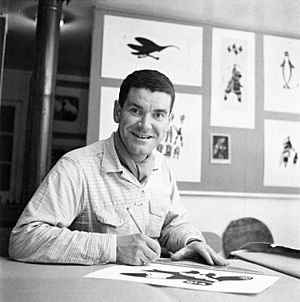James Archibald Houston facts for kids
Quick facts for kids
James Archibald Houston
|
|
|---|---|

Houston preparing a mount for an Inuit print, in Cape Dorset, photographed by Rosemary Gilliat Eaton, 1960
|
|
| Born | June 12, 1921 St. Catharines, Ontario, Canada |
| Died | April 17, 2005 (aged 83) |
| Occupation | Author |
| Genre | Children's literature |
James Archibald Houston (born June 12, 1921 – died April 17, 2005) was a Canadian artist, writer, and filmmaker. He is famous for helping the world discover Inuit art. He also taught the Inuit people how to make prints. The Inuit called him Saumik, meaning "the left-handed one."
Contents
About James Houston
James Houston was born in St. Catharines, Ontario, Canada. He loved art from a young age. He studied art in Canada, Paris, and Japan. In Japan, he learned about printmaking. He served in World War II and received a medal for his service.
After the war, he moved to the Eastern Arctic. He lived there for twelve years. He worked as a government officer in western Baffin Island. In 1962, he moved to New York. There, he worked as a design director for Steuben Glass.
Helping Inuit Art Grow
Perhaps James Houston's biggest achievement was his work in the Canadian Arctic. In 1948, he traveled to an Inuit community called Inukjuak. He went there to draw and paint the Inuit people and the Arctic landscape.
He traded his own drawings for a small carving. It was a carving of a seated deer made by an Inuit hunter named Nayoumealuk. Houston saw how special this carving was. He took about a dozen small carvings back to the Canadian Handicrafts Guild in Montreal. These carvings were mostly made from soapstone.
The guild was very impressed by the carvings. They had tried to help Inuit artists before. They were also impressed by Houston. The Canadian government gave them money to buy more carvings. Houston went back north in 1949 to buy more art.
When Houston returned to Montreal, the guild held its first exhibition of Inuit carvings. All the art sold out quickly. The government then put more effort into helping Arctic art. They hired Houston to live in Cape Dorset. He became the first "roving crafts officer." He also wrote about the art to help sell it in the south.
The art sales became a yearly event. People would line up down the street to buy the art. By the late 1950s, Inuit art was shown in Europe, South America, and the Middle East. After helping Inuit sculpture become popular, Houston introduced printmaking in 1957. It was also a great success.
Houston lived in Cape Dorset with his wife, Alma Houston, and their two sons, Samuel and John. In 1962, he moved to New York City. He wrote and produced a film called The White Dawn in 1974. This film was based on his own novel. In 1976, his large sculpture "Aurora Borealis" was placed in the Glenbow Museum in Calgary. It is still there today. James Houston passed away in New London, Connecticut, at the age of 83.
Awards and Honours
James Houston received many awards for his work:
- He was a Fellow of the Royal Society of Arts.
- He was an honorary member of the College of Fellows of the Royal Canadian Geographical Society.
- In 1972, he was made an Officer of the Order of Canada. This is one of Canada's highest honours.
- He received several honorary degrees from universities. These degrees recognized his achievements in literature and fine arts.
- In 1977, he won the Vicky Metcalf Award for Literature for Young People. This award is for Canadian children's writers.
- In 1997, he was awarded the Massey Medal from the Royal Canadian Geographical Society.
Books by James Houston
James Houston wrote many books for both children and adults.
Books for Children
- Akavak: An Eskimo Journey, 1968.
- Black Diamonds: A Search for Arctic Treasure, 1982.
- Drifting Snow: An Arctic Search, 1992. This book won the 1993 Governor General's Awards.
- Eagle Mask: A West Coast Indian Tale, 1966.
- The Falcon Bow: An Arctic Legend, 1986.
- Frozen Fire: A Tale of Courage, 1977.
- Ghost Paddle: A Northwest Coast Indian Tale, 1972.
- Ice Swords: An Undersea Adventure, 1985.
- Kiviok's Magic Journey: An Eskimo Legend, 1973.
- Long Claws: An Arctic Adventure, 1981.
- River Runners: A Tale of Hardship and Bravery, 1979. This book won the 1980 Canadian Library Association Book of the Year for Children Award.
- Tikta'liktak: An Eskimo Legend, 1965. This book won the 1966 Canadian Library Association Book of the Year for Children Award.
- The White Archer: An Eskimo Legend, 1967. This book won the 1968 Canadian Library Association Book of the Year for Children Award.
- Whiteout, 1991.
- Wolf Run: A Caribou Eskimo Tale, 1971.
Books for Adults
- Confessions of an Igloo Dweller, 1995.
- Eagle Song: An Indian Saga Based on True Events, 1983.
- Eskimo Graphic Art: 1964-1965, 1965.
- Eskimo Handicrafts, 1951.
- Eskimo Prints, 1967.
- Ghost Fox, 1977.
- Hideaway: Life on the Queen Charlotte Islands, 1999.
- The Ice Master: A Novel of the Arctic, 1997.
- Ojibwa Summer, 1972.
- Running West, 1989.
- Songs of the Dream People, 1972.
- Spirit Wrestler, 1980.
- The White Dawn: An Eskimo Saga, 1971.
- Zigzag: A Life on the Move, 1998.
Images for kids


